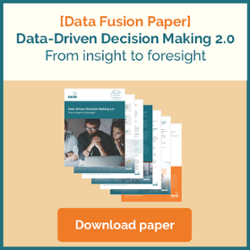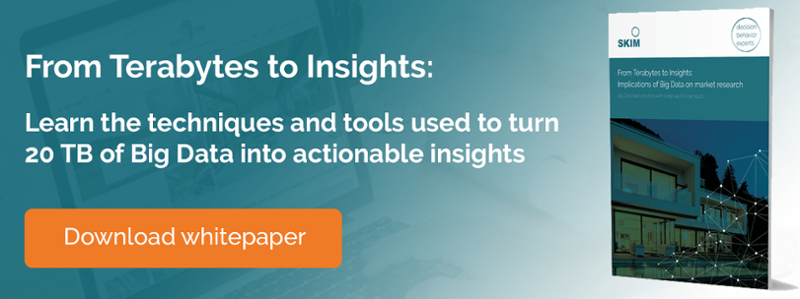Exploring expert views on AI and the role of ‘stats’ in market research
Machine Learning (ML) is everywhere, from social media and virtual assistants to financial services and data security. For sales and marketing professionals, machine learning offers unprecedented analysis of big data. It holds the potential to decode increasingly layered buyer journeys. However, does machine learning truly have a role in market research, a field where we rely on analytical methods to understand nuanced and complex decision-making? Or, is statistical thinking still the essential analytical element behind the insights we deliver today?
These were the questions posed during the 2019 MRS Data Analytics conference held in London. I joined peers from Sky, Boxclever and Honeycomb to explore this topic during the “The Role of Statistics and Machine Learning in market research” panel.
Here’s what we had to say and what you need to know about the future of market research.
The times, they are a changin’: machine learning as a market research disruptor
As machine learning enters the arena with a vengeance, companies, particularly marketers and insights professionals, are attempting to quickly adapt to this new analytics paradigm. Despite this vibrant interest in machine learning, my fellow panelists and I notice how much confusion exists about when to use it, versus when to use more traditional statistical approaches.
Should machine learning be treated as an essential tool for market research analytical teams? Do statistical methods still have a role to play, and if so, when is a statistical model preferable to a machine learning solution?
Aji Ghose, Head of Research & Analytics at Sky, the insights and decision science arm of the major broadcaster, weighed in on the topic. Ghose revealed that even though Sky’s analysts employ around 90% ‘traditional’ statistical methods, they have also experimented with the use of a neural network to make sense of images, classifying images and video automatically.
What is the place for Machine Learning in the market research mix?
1. The best uses for Machine Learning
All the experts agreed that Machine Learning is best used when investigating tactical objectives, for example in pricing research when you’re predicting price increases. The appeal of Machine Learning is ‘predictive accuracy’.
However, Machine Learning alone can’t produce qualitative reasons for what it predicts or observes. Major revenue strategy decisions need more rigorous analysis: key stakeholders, such as brand managers or retailers will need to be persuaded with an understanding of the reasons behind consumer or B2B decision-making. The underlying “why” can’t be provided through Machine Learning alone.
In addition, Machine Learning can’t offer up long-term strategies. For example, eCommerce suggestion engines of the ‘If you like this, you’ll love that’ variety can provide simple judgements based on observation of consumer habits, but they can’t delve any further into a consumer’s likely decision-making behavior.

2. A hunger for data
Machine learning needs a lot of data to provide a meaningful result. Other research methods can actually do more with less, i.e. produce more useful outcomes using far less data. How is this possible? Market research statisticians work with focused data sets selected for relevance, whereas both machine learning and big data techniques use large data sets originally designed for other purposes.
This scenario was top of mind with the audience at the MRS Data Analytics Conference. They questioned whether we should be concerned by the quantity of data now available. From the audience, my colleague Marcel Slavenburg, Senior Director, SKIM, explained that a wider range of data sources, such as Machine Learning, big data, and third party and sales data, is useful for ‘triangulation’. Using additional information sources gives a better feel for the context of decision-making. More information lets you ground the data for a more nuanced understanding, and that produces more accurate and actionable insights.
3. How companies use their data
In today’s digital world, many of our clients are gathering massive amounts of customer data, but are challenged with knowing how to effectively leverage it. They may have information collected in silos (e.g. social listening, CRM data, online data etc.), but may not be sharing it widely internally. Sound familiar?
At the panel, I discussed the wide variations in corporate data science usage, from none — to companies with data science teams integrated with all aspects of data and insights. While some are using Machine Learning and other methods to gain a 360-degree view, others are yet to define a strategy that will allow them to do so. It was evident that integration and partnerships are a way to develop the kind of contextual understanding Marcel described.
4. Beware of mislabelling
During discussions, Bethan Blakeley, Director, at data science agency Honeycomb, raised the point that ML and AI have become such buzzwords that market research solutions could be misrepresented as using these new technologies, although they are actually ‘traditional’ methods. This confusion highlights the importance of choosing market research partners with a broad range of expertise and experience, so you get the benefits of all available methods. An agency partner with deep analytical roots can evaluate the business context with all methods (old and new) to create the best bespoke research strategy for your brand.
How to get started with Machine Learning in market research
From our perspective at SKIM, machine learning has a definite role in advanced analytics today. However, it’s best implemented as part of a sophisticated analytical toolkit.

When putting together an analytical team or bringing in external experts, they should be well-versed in:
- Being able to communicate effectively across the different cultures, sectorial jargons and “vocabularies” existing in the different teams owning different datasets or having interests in exploiting them
- Considering the context in which datasets were created
- Continually questioning the data sources with common sense and alignment to the ultimate business objective
- Leveraging the best analytical solution for the objective – being method agnostic – such as moving from a more automated to a more ad hoc solution, or vice versa
These criteria will produce the most meaningful outcomes from the data.
If you’re looking to do more with your data, we can advise you. The result will be an insights strategy that protects and nurtures your business as it aims for long-term growth. We have a long history of expertise in decision behavior, analytical methods and understanding of today’s marketing challenges, plus full integration of data and analytics. We’ll team up with you to design a collaborative data-science approach that gets your data journey started right.
Want to know if you are using machine learning outcomes in the best way for your business?  to discuss how we can help.
to discuss how we can help.




